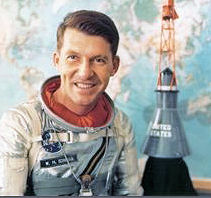 NASA honored veteran astronaut Walter M. Schirra, Jr., as an Ambassador of Exploration today during a ceremony at the San Diego Aerospace Museum.
NASA honored veteran astronaut Walter M. Schirra, Jr., as an Ambassador of Exploration today during a ceremony at the San Diego Aerospace Museum.
NASA is presenting these prestigious awards to the astronauts who took part in the nation’s Mercury, Gemini and Apollo space programs from 1961 to 1972. Schirra, a San Diego resident, is the only man to fly in all three space programs. Ambassadors of Exploration help NASA communicate the benefits and excitement of space exploration.
In addition to receiving the Exploration Award plaque, Schirra was presented with a moon rock to recognize the sacrifices and dedication of the Mercury, Gemini and Apollo astronauts. The moon rocks are part of the 842 pounds of samples returned during the six lunar expeditions from 1969 to 1972. The moon rock will remain on display in the museum.
Initiated in 1958, Project Mercury was America’s first human space program. The objectives of the program’s six human flights from 1961 to 1963 were to orbit and safely recover a manned spacecraft and investigate man’s ability to function in space.
Schirra was one of the seven original astronaut pioneers of the Mercury Project. He flew the spacecraft Sigma 7 on the fifth manned flight on October 3, 1962 for 9 hours, 13 minutes, 11 seconds. The mission proved astronauts could perform maneuvers in space.
Schirra flew as Command Pilot aboard the 1965 Gemini 6 mission with co-pilot Thomas Stafford. The highlight of the mission was the successful rendezvous with the already orbiting Gemini 7 spacecraft. The crews accomplished the first rendezvous of two manned maneuverable spacecraft.
Schirra was Command Pilot aboard Apollo 7 in 1968 with Command Module Pilot Donn Eisele and Lunar Module Pilot Walter Cunningham. The mission measured the accuracy and performance of spacecraft systems and provided the first effective television transmission of onboard crew activities.
Schirra is an author, Emmy Award winner and member of four aviation halls of fame. Generations of Americans remember him from his television coverage of the U.S. space program from 1969 to 1975; including co-anchoring with Walter Cronkite when Apollo 11 landed on the moon.
For Schirra’s astronaut biography on the Web, visit:
http://www.jsc.nasa.gov/Bios/htmlbios/schirra-wm.html
For San Diego museum information on the Web, visit:
www.aerospacemuseum.org